Guitar picks are the unsung hero of the guitar world, often treated as little and expandable pieces of plastic. More often than not, they’re under-appreciated, even though they are responsible for the tone of your guitar, no less than the type of strings or pickups you use.
In this article, we’ll look into different types of guitar picks, including pick materials and how they affect the sound of the guitar, as well as different pick shapes, and gauges. We’ll also look at different ways pick makers add grip to their picks, how different tip slopes affect playability and sound, and at the very end, we’ll look into ergonomic picks. This is an exciting journey guitar players can take down the rabbit hole of experimentation with different materials, gauges, shapes, and whatnot. Each will introduce different characteristics to your sound, as well as reshape the way you play.
Table of Contents
Different Types of Guitar Picks
Guitar picks, like most guitar-related accessories, got more complicated over time. There are three main different types of guitar picks:
- Flat Picks – The most common type of picks. This is what comes to mind when most people think of a guitar pick.
- Thumb Picks – A type of guitar pick worn on the thumb. A thumb pick is usually used to pluck the bass strings.
- Finger Picks – Finger picks are more often than not paired with a thumb pick and used to pluck or strum the bottom strings of the guitar.
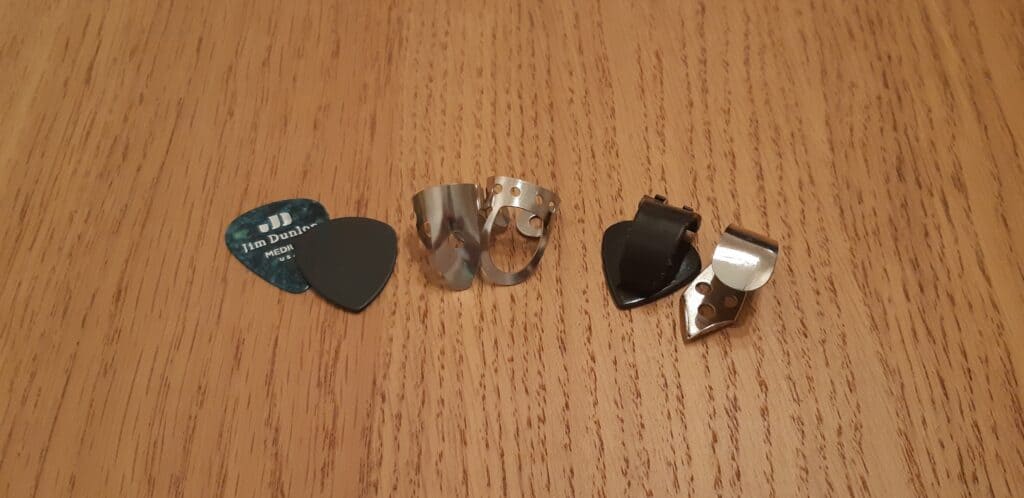
What are Guitar Picks Made Of?
Most guitar picks are made of Celluloid, Nylon, Delrin, or Tortex (which is another type of Delrin). Additionally, there are hundreds of materials guitar pick makers use. Everything from Celluloid to Nylon, all the way to different species of wood, types of stones, metals, bones, horns, and some even make their own materials. I’ve all the materials guitar picks are made of into 6 groups:
- Plastics
- Woods and plant-based materials
- Stone, Glass, and minerals
- Metals
- Animal products
- Other materials
Types of Plastic Guitar Picks
The most common family of materials used to manufacture guitar picks at large scales. Even though some plastics were used since the early 1900s, they only increased in popularity after Tortoiseshell picks became illegal in the 1970s.
Celluloid
The most common material used to make guitar picks. This is the original substitute for Tortoiseshell. If you have a guitar, chances are that you are pretty familiar with Celluloid picks. Celluloid is known as one of the most flammable plastics. Notable Celluloid picks include D’Andrea Celluloid Picks and Fender’s line of Celluloid picks.

Delrin / Acetal
Delrin is a material pick manufacturers used since the early 70s as a way to mimic Tortoiseshell’s feel and sound beyond what Celluloid could. It sounds a lot warmer and is a lot stiffer. Delrin can have 2 different types of finish: Glossy, like Delrin 500 by Jim Dunlop, and Matte finish, like Ernie Ball’s Prodigy

Tortex
Tortex picks are Jim Dunlop’s version of Delrin. They are equally warm and stiff, and I can barely distinguish between them in a blind test. The classic range of Dunlop’s Tortex picks is one of the most recognizable lines of picks ever made.

Nylon
Nylon is in use for guitar picks since the early 70s, too. It is part of a sub-groups of plastics called Thermoplastics, meaning: it can easily be reshaped by reheating it. This fact makes it one of the easiest materials to work with. Nylon picks are very flexible but are known for their low durability. This is due to the way big manufacturers are processing the material, rather than a testimony of Nylon’s strength. Pick makers such as AttakPik and Rombo Picks are using a much slower (and more expensive) heating process, making their Nylon picks very durable. Some notable Nylon picks are Dunlop’s Jazz III, Rock III, and 44R.

Ultem / Ultex
Ultem (or polyetherimide) is one of the most durable thermoplastics used for making guitar picks. It is heat-resistant (to a certain degree), very stiff, and usually half transparent. Developed in the early 80s, it is also used in medical equipment, chemical lab equipment, and aerospace components. Notable Ultex picks are Dunlop’s 421P series and picks of Dunlop Primetone Series.

Acrylic
Acrylic is a thermoplastic usually used for making high-end guitar picks. Being more wear-resistant than most other plastics makes Acrylic a great material for guitar picks. With makers such as Honey Picks, V-Picks, Gravity Picks, BHL Picks, Northern Ghost plectrums, Plumstone Guitar Picks, Osiris Accessories, and more.

Kirinite
Kirinite is the commercial name of hardened Acrylic made by a company of the same name. They are very similar to Acrylic in sound and feel, but a lot more resistant and durable. It is relatively easy to work with Kirinite, making it a common material at some high-end makers, such as Dragon Picks, Honey Picks, Luka Plectrums, and many others. After seeing a few picks made from Kirinite, you’ll notice a design pattern. This is because there’s only one company that creates the sheets used by pick makers.

Acetate Acrylic
Acetate Acrylic feels “glassier” than either Acrylic or Kirinite, even though it belong to the same family. It sounds bright and is very rigid. Pick made from it are usually very thick, 4mm and up, because of the material supply. Arcanum Plectra uses it as part of his regular collection.

Galalith
Tone-wise, Galalith is usually compared to Tortoiseshell and Ivory. They sound very similar because of their chemical similarity, as they are both based on Keratin. That’s also the reason why it’s often colored in the same colors. Galalith is the product of the interaction of Casein and Formaldehyde. This is the reason a lot of makers are confusing Galalith with Casein. That being said, whenever you see a Casein or Casein/Galalith pick, you can be certain that it’s made of Galalith and nothing else, as Casein is not a type of plastic. It’s a bit expensive compared to other types of plastics but will be a great help if you’re looking for a vintage sound.
Galalith picks are made by Hawk Picks and Honey Picks.

Polyetheretherketone (PEEK)
The plastic industry is not known for the catchy names they give their products. Polyetheretherketone (or PEEK, which is just the perfect name for a pick material, isn’t it?) is lightweight, resistant, and produces a very balanced tone. Another version of it, also used for making guitar picks, is a mixture of it and Graphite. A maker using Peek is Luka Plectrums, which also helped me with information about this material.


Lexan
Lexan is a brand name given by General Electric to the plastic they discovered, which is, in fact, polycarbonate resin thermoplastic. It is 250 times more resistant to impact than glass, and 30 times more than Acrylic. That being said, Lexan is usually a lot less durable than Acrylic when it comes to guitar picks because the version used in picks is very rigid and sensitive to denting.
An interesting fact about Lexan is that Bayer actually came up with its formula separately, and applied for a US patent a week before GE. It was branded under the name Merlon, and later changed to Makrolon.

Thermosetting Plastic (Thermoset)
Thermosetting Plastic, often wrongfully called Thermoplastic (which is the exact opposite) sits on the other side of the “plastic spectrum” than Nylon. It requires a very high temperature and pressure to shape, and once it settled into its new form – there’s no way back. This fact makes it extremely durable, rigid, and very bright sounding. There are many types of Thermosets, but sometimes pick makers will just call their material “a thermoset”, especially if they added their own twist to the formula. A good example of thermoset picks is Chicken Picks.

UHMW-PE
A very not catchy synonym to the most unoriginal name: Ultra High Molecular Weight Polyethylene. UHMW-PE is very durable and not flexible. It has some self-lubrication qualities, allowing it to glide across the strings easier. An example of a pick maker known for using UHMW-PE is Purple Plectrums, but other makers such as BHL and Winspear are using it, too.

Teflon (PTFE)
Teflon is a heat-resistant type of plastic used for many different things but is most known for being used on non-stick cookware. In the context of guitar playing, Teflon is known for its great grip, high durability, very little string noise, and warm tone. There aren’t many pick makers who are using it, but some examples are Ace Performance Picks and Pick Heaven.

Rubber
Rubber picks are usually meant to be used as ukulele picks. Being that flexible makes them ideal for strumming, but almost impossible to be used for lead. Their flexibility is also one of the reasons they are so durable. A maker using rubber is Timber Tone.

Vinyl
Vinyl guitar picks are pretty rare and mostly made from recycled Vinyl records. I couldn’t find any makers that are making significant work with Vinyl other than a few Etsy sellers.
Polycarbonate
Polycarbonate is a family of thermoplastics, containing some of the most durable materials. Different types of Polycarbonates are often represented by their type of resistance, such as Bullet-proof Polycarbonate, Abrasion-Resistant (AR) Polycarbonate, etc… Polycarbonate picks sound a lot like Kirinite, bright and aggressive. They are not too common but are made by a company called Telefunken.

Juma
Juma is another material known for its design rather than for its characteristics. It is made by a company named Elforyn in Germany and is a composite of different minerals with Resin. It feels a lot “glassier” than many other resin-based materials, and it sounds a bit brighter, too. Dragon Picks, Luka Plectrums, and Zen Guitar Picks are using it in their designs.

Vespel
A heat-resistant, self-lubricant, high-performance, aerospace-grade polyimide-based plastic made by DuPont. Its high durability and self-lubricating characteristics make it a perfect material for guitar picks, but being a lot more expensive than other materials on this list prevents it from being widely used. It also sounds a lot warmer than other materials of the same toughness. Vespel Picks are made by Charmed Life and BlueChip Picks.

Bakelite
Bakelite, also known by its less catchy name: Polyoxybenzylmethylenglycolanhydride (I kid you not) was invented in 1907 by a Belgium chemist named Leo Bakeland in New York. This is a thermosetting, non-flexible, scratch-resistant plastic. Bakelite is quite rare because it’s not made anymore. There are currently two makers that I know of that make Bakelite guitar picks, so if you’re in the market for one, check out Dragon Picks or Luka Plectrums.

Catalin
Catalin is another type of thermosetting plastic and is often confused with Bakelite. The reason for this confusion is that Catalin is based on Bakelite, and is basically a more updated version of it. It is almost colorless and as hard as Brass, so many consider it the superior version of Bakelite. Catalin feels a bit greasy to the touch, but this feature helps it glide very smoothly across the strings. The only maker I know that makes Catalin picks is Luka Plectrums.

Tusq & Faux Ivory
Made to mimic the sound characteristics of Ivory, these materials sound a lot like Bone, Horn, and Tagua. They have some minor differences between them, but they are similar enough to be considered as one. They are very tough, durable, and bright-sounding. Tusq is processed exclusively by Graph Tech, and is being used to make picks, saddles, nuts, and bridge pins. And even though it’s made to mimic Ivory, it comes in white, cream and black. Faux Ivory, on the other hand, usually comes in White, and is used by Iron Age Accessories to make their Parthenon series.

Guitar Picks Made of Proprietary Blends
Some guitar pick makers use their own materials or blend of materials. Proprietary blends are often made to cover a specific characteristic or a set of characteristics. For example, Hippie Picks‘ blend is made to eliminate pick chirp, to help with grip, and to glide across the strings effortlessly. Other makers who use their own proprietary blends are Pickboy, with their Nylon/Ceramic blend, Ace Performance Picks, and more.

Woods And Plant-Based Picks
Wood is a rather common material in the guitar pick world, gaining a lot of popularity in amongst boutique makers. Even though it may look like it’s a relatively new material for picks, it dates back to ancient Greece, where it was used to pluck the lyre. Other plant-based materials, such as Tagua, are also offering different textures and sound textures to this group of materials.
Wooden Guitar Picks
Being softer than a lot of other synthetic materials, a wooden guitar pick will most likely (depending on the actual wood species) have some warmth to its sound. The hardness level of the wood (measured by the Janka test) determines a lot of its characteristics, but that’s not all. The grain density, the direction of the grain, and even the moisture level can have a huge impact on the sound of a pick.
Wood species commonly used for making guitar picks (sorted from softest to hardest) are Mahogany, Ash, Bamboo, Hard Maple, Zebrawood, Wenge, Blackwood, Rosewood, Tigerwood, Purpleheart, Bubinga, Cocobolo, Ebony, Ironwood, and Kingwood.

Pick makers using wood as their main material includes TerraTone, GT Plectrums, and Tree Picks. Other makers, such as Plumstone Guitar Picks, use wood for some of their models. Wood is a great introductory material for making picks. Some makers, such as Hippie Picks and Osiris Accessories used wood for their first picks and then shifted to other materials.
Coconut shell
Coconut shell is used for guitar picks because of its hardness and density, resulting in a durable, bright-sounding pick, with some sound texture that resembles wooden picks.

Tagua Nut (Corozo)
The Tagua nut is becoming more and more popular in guitar picks. Sound very bright and similar to Bone and Horn. Howling Monkey Picks has been using Tagua to create guitar picks since 2011, but today it is used by many other boutique makers too. Often, it is used together with other materials such as Acrylic and Wood to create unique designs. More notable makers are JB Guitar Picks, Crow’s Customs, and Honey Picks

Metals
Metal guitar picks have been around since the late 60s, originally made by small makers such as Dr Guitar Picks. A few years later, Jim Dunlop released TeckPick, which is still in production today. Metal guitar picks are not as common as other materials because they tend to break the strings faster than other softer materials.
Titanium
Titanium picks are becoming less rare these days, thanks to pick makers such as OhmPicks, Timber Tones, Isbey Custom Designs, and Alpha Atomic. These picks are extremely bright sounding, and will most probably last forever.

Stainless Steel
Another fairly popular material used by metal pick makers. It’s cheaper and easier to work with, compared to Titanium. An example of a pick made out of Stainless Steel is Jim Dunlop’s 46RF. In addition to flat picks, Stainless Steel is very popular in fingerpicks, with makers such as National, ProPik, Dunlop, and Ernie Ball.
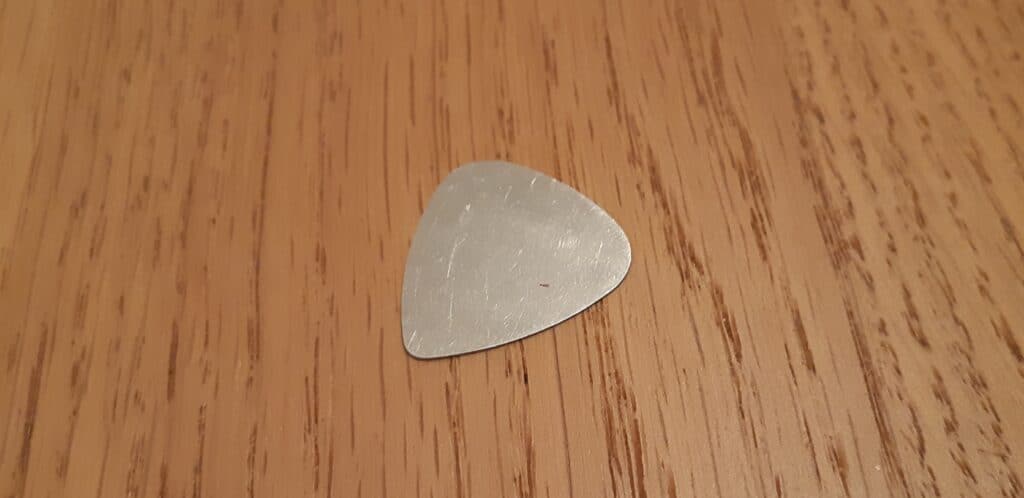
Copper
Copper is a lot softer than other metals and is used by specialty makers such as Zenfire, and artisan makers like Nici’s Picks. Being so soft, it is not too uncommon for copper picks to bend when gripped firmly. Copper guitar picks sound warmer than other metals.
Bronze
Bronze Picks, often made from cymbals, sound slightly warmer than stainless steel and are a bit heavier, too. This is not always clear whether a pick was made out of Bronze or a Brass cymbal. You might want to make sure before you buy them if it’s important to you.

Brass
Brass picks sound very similar to Bronze picks (after all, Brass is 80% bronze), but are a lot more durable. Specialty and artisan pick makers such as Dr Guitar Picks, Nici’s Picks, and Dugain Picks are using Brass as one of their core materials.

Silver, Gold, And Other Precious Metals.
Precious Metal picks are usually not bought for their sonic properties, as they are more of a piece of jewelry in a box. It doesn’t take away from their cool factor, but I’m afraid that this is the most they have to offer, especially considering their price.


Stone, Glass, and minerals
Stone guitar picks are known for their variety and are surprisingly warm for being so rigid. When playing with a stone pick you can expect no flexibility, and the pick will usually be thicker than 1.5mm. Being that stiff, they tend to break fairly easily if you drop them (don’t ask me how I know). The pick’s tone would be affected by the shape more than it will by the type of stone your pick was made of, even though you can’t ignore the material’s effect either.
Types of minerals and stones often used for guitar picks are: Obsidian, Agate, Aventurine, Amethyst, Jade, Opal, Jasper, and more. In addition to these, some pick makers are using Cast Stone (reconstituted stone), which is crushed stones glued together. A maker whose specialty is making stone picks is Third Stone Guitar Picks (formerly known as Saluda Picks)
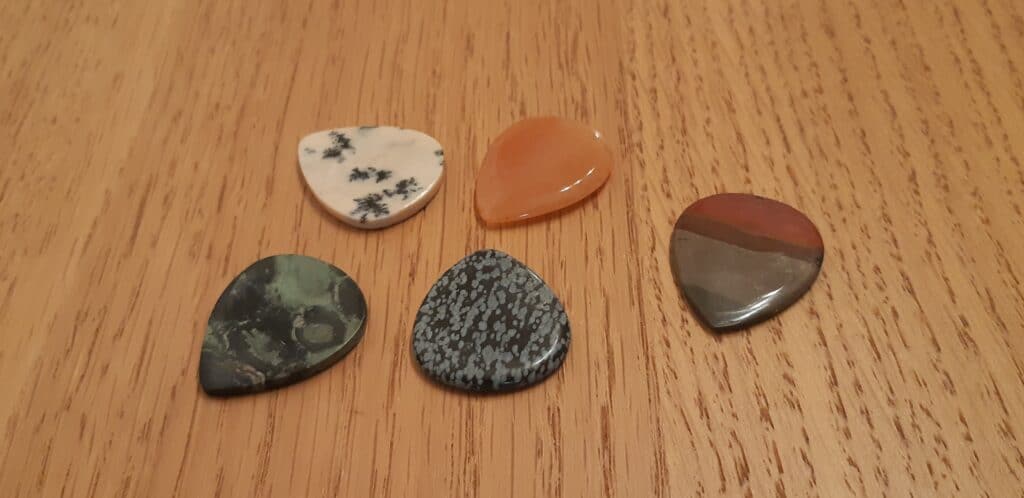
Glass
Working with Glass requires a very high level of skill and a very specific set of tools. This is probably the reason why these are so rare among plectiers. Because guitar picks are relatively small, and glass picks are usually 2mm thick and up, they won’t break that easily. I’ll even go farther and say that they are most likely more resistant than most stone picks. Notable makers using Glass as their primary material are Morningstar and Silica-Sound.

U-Glass
U-Glass is a special composite made of Ultem and Glass. It creates a unique material that is durable, and yet, feels relatively “glassy”. As far as I know, BHL are the only ones using it for guitar picks.
Resin / Epoxy
Resin and Epoxy picks are very common among pick makers and artisans, because of the flexibility they offer in terms of design. There’s a big variety of Resin and Epoxy blanks, and some makers are even making the material themselves. Epoxy’s design flexibility allows makers to easily make some of the most beautiful guitar picks. Another thing commonly found is for makers to keep the material uncolored, making it look like polished glass. Some makers who regularly use Epoxy are Timber Tones and Dragon Picks.

Animal Products
Using animal products to pick stringed instruments dates back to ancient Rome and Greece when musicians used Feather Quills to pick Lyres. Over time people started using other animal products such as Bones, Horns, Tortoise Shell, Leather, and more. A lot of pick makers are using animal products only from animals that died of natural causes. This is, of course, not true for all of them, but it’s very nice to see.
Bone
Very hard and dense material, usually used for guitar nuts and bridge saddles. Being a natural material, unless it’s been polished to a very high level, it has some friction that makes the release from the strings a bit tough. Many makers are using bone for their picks, including Dugain, Osiris, and Timber Tones.

Horn
Very similar in sound and feel to Bone, but a bit more flexible. A horn pick is often semi or fully see-through, making it look a lot more interesting. Many different makers are making Horn guitar picks, including Dugain, Timber Tone, and Stadler Picks. Stadler Picks exclusively uses Horn sourced from Water Buffaloes that died naturally.

Deer Antler
Picks made out of Deer Antler resemble bone picks more than they resemble horn picks. They sound bright and rich, less warm than horn picks. Their texture, on the other hand, is unique. Smooth and rigid on one side, and softer on the other, providing excellent grip. A maker known for making pics out of Deer Antler is Valley Picks.
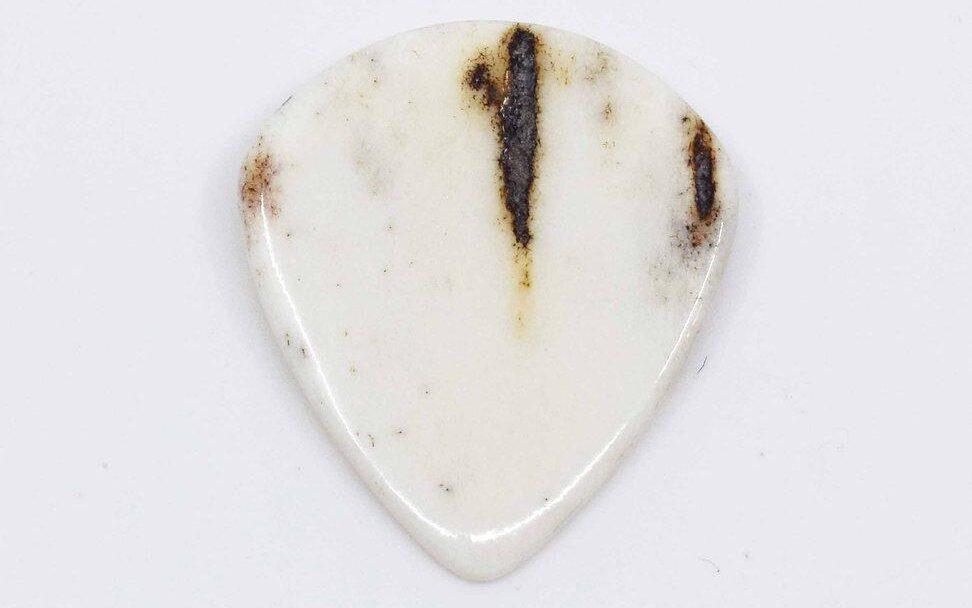
Leather
A very common pick material for Ukuleles. It’s very flexible, warm sounding, and usually two-sided. One side is suede-like and the other one is tougher, helping it mimic the sound of strumming with the finger, with a slight twist. The end result is the classic ukulele pick sound. Makers using leather as a pick material Include Timber Tones and Anwenk.
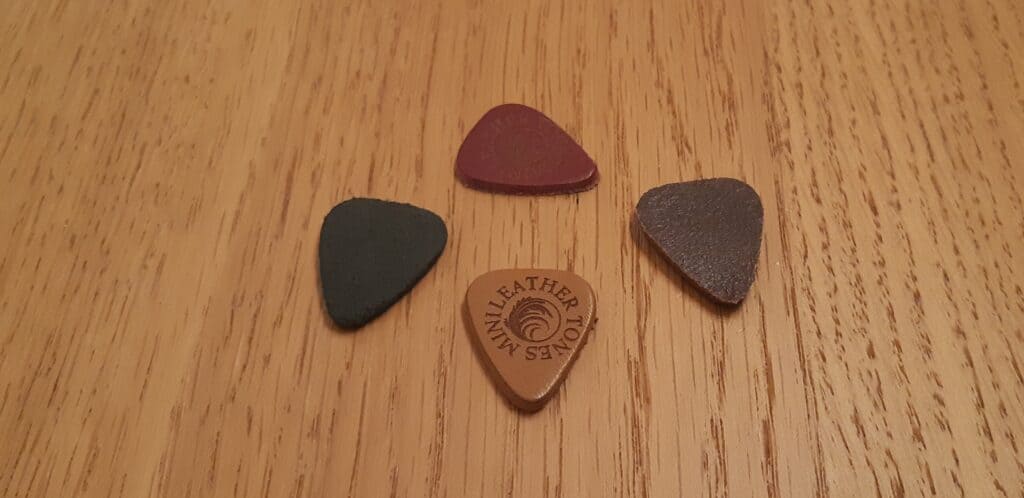
Mother of Pearl
Mother of Pearl is a very tough, rigid, and smooth material, resulting in a bright tone with a very clean attack. Most people prefer Mother of Pearl picks for strumming and rhythm, but I think it compliments lead very well. Makers using Mother of Pearl include Timber Tones.

Seashell
Very similar in character to Mother of Pearl, but is available in higher gauges, too. The processing of Seashell picks makes their bevel slightly less smooth, resulting in a more textured attack. Being that rigid, Seashell picks tend to break if they fall, but if you treat them with care, they will last for years without any sign of wear.
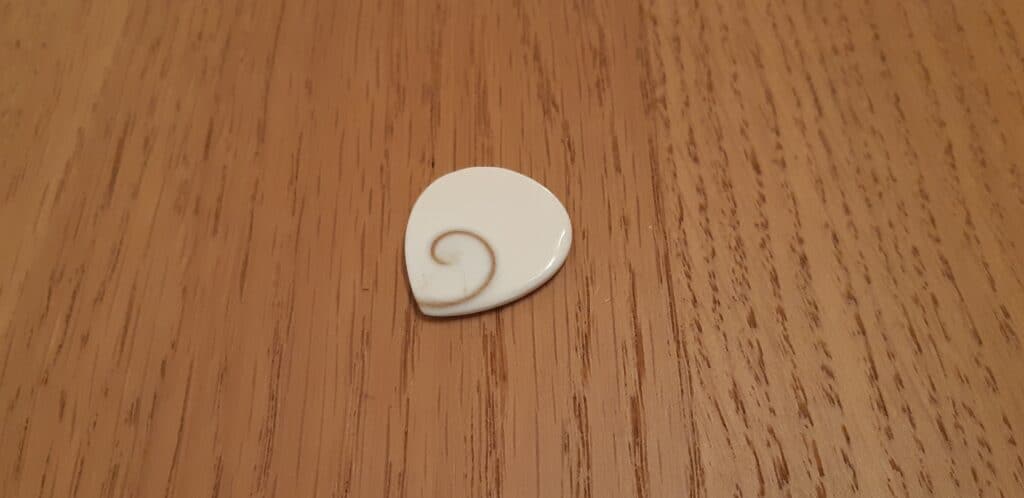
Tortoise Shell
One of the most popular materials ever used for guitar picks, until it was banned in 1977 to save the hawksbill turtle from extinction. People often consider Tortoiseshell picks to be superior in tone, but this is probably just because they are not available anymore. Especially since there are so many other alternatives with similar sonic qualities.
The first Tortoiseshell pick was designed and patented by John Farris in 1885, as an alternative to feather quills, which were very popular until that point. It sounds warn, with a round attack.
Other Materials
Since there’s an infinite number of combinations and new materials being introduced to the guitar picks world, not every material fits one of the categories from above. So here, I listed guitar pick materials that are either a combination of materials from 2 groups (or more) or materials that belong to none.

Stabilized Wood
Wood stabilization is the process in which wood is “infused” with Resin or Acrylic. The main difference between wood and stabilized wood is that stabilized woods weigh more, are more durable, and, well, are more stable. Stabilized Wood picks are more consistent in texture, and in a way, have the benefits of synthetic materials while still keeping the unique sound textures of wooden picks.
There are many types of wood stabilization. Some are as decorative as they are stabilizing (as you can see in the image below), but some have very low to absolutely no effect on the looks of the wood.

Carbon fiber
One of the toughest materials used to make guitar picks. Carbon Fiber is so tough and rigid, that Pick Haven are making the world’s thinnest guitar pick out of it, at 0.2mm. Some of its characteristics include having no flexibility and rough sandpaper-like edges.

Felt
Felt, either cotton based or synthetic, is often used in ukulele picks. They sound muffed and are not so durable, but are perfect for strumming Nylon strings. Pick makers that use felt include Timber Tones, Mudder, and big companies such as D’Addario, Dunlop, and Fender.
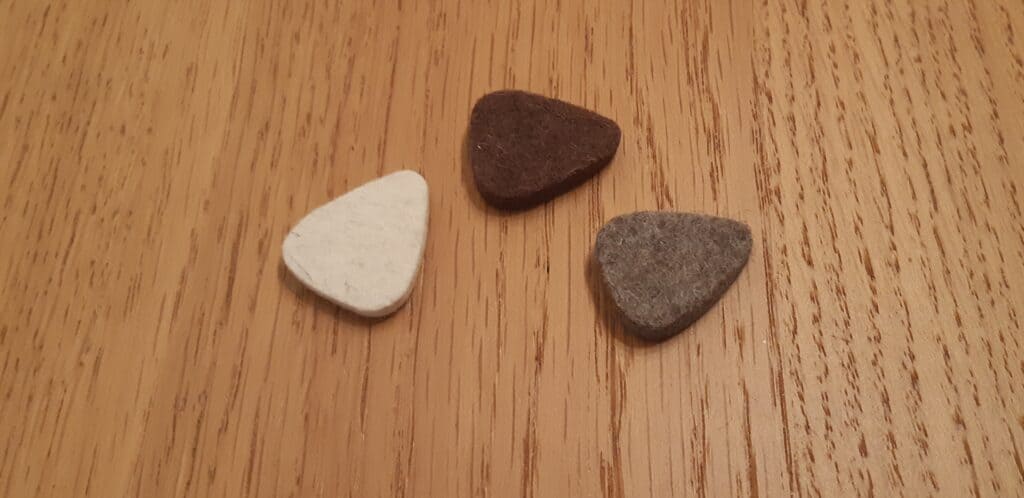
Richlite
Richlite is a composite of paper and epoxy made exclusively by a company of the same name. It’s sustainable because it is made of recycled paper, it’s easy to work with and very durable. Luthiers are using it for making Fretboards, and many people often compare it to Ebony’s for its sonic characteristics. Among the makers using Richlite as a material are Leaf Picks and Dragon Picks.

Micarta
Micarta is a composite of canvas and thermosetting plastic, pressed under high pressure and high temperature. It was invented in 1910 and is made by a company named Norplex. Micarta picks are made by Luka Plectrums and GT Plectrums.

Crazy Fiber
Crazy Fiber is very soft, making it sound very warm. This is also what makes it not as durable as other materials. Crazy Fiber’s designs are very distinguished from other materials, making them instantly recognizable. It isn’t the main material used by any pick maker I know, but Dragon Picks occasionally release them.
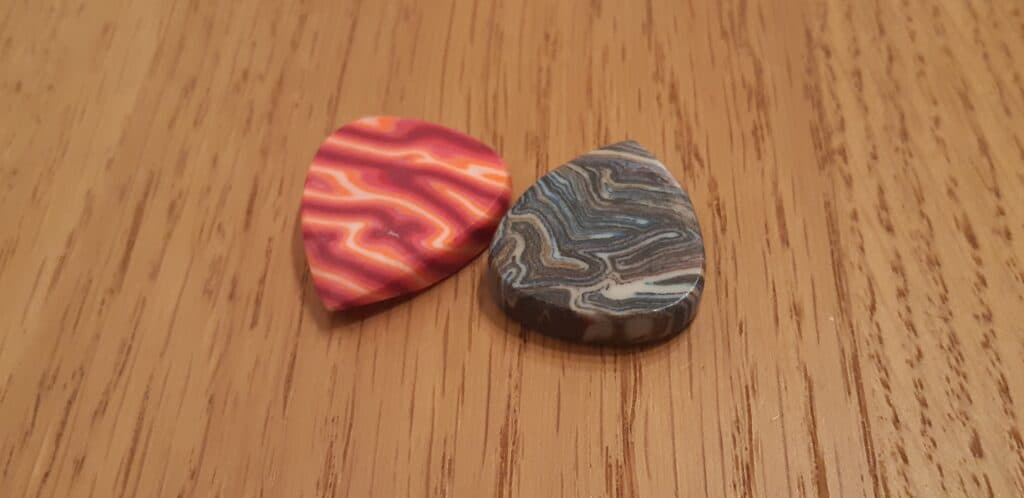
Different Guitar Pick Shapes
Guitar picks come in many shapes and sizes. Some of the most common shapes are standard, jazz III, teardrop, triangle, sharkfin, and pointy (sharp). Most boutique makers are creating their own variations, but they’re mostly based on these.
Below is a basic explanation of the most common shapes you can find. If you’re interested, you can read more about guitar pick shapes in this article.
Standard and Common Guitar Pick Shapes
There are a few guitar pick shapes that, over time, became standards. Here they are, with some additional information on each.
Standard (Classic 351)
The Standard guitar pick shape is what comes to mind when most people think of a guitar pick. It was designed in the 1920s and manufactured by D’Andrea under the name 351. It’s still in production and made in the same factory, often referred to as the pick that started it all. This is because this is the pick that started the shift towards mass-produced plastic picks.
Jazz III
Jazz III was released in 1976 and designed by Jim Dunlop himself as an attempt to create the perfect pick for jazz. It was introduced together with two additional designs: Jazz I and Jazz II. This shape is smaller and sharper than the Standard pick, favoring playing lead over strumming. Today, most guitar pick makers have their own version of it, so if you like the shape, you have plenty of alternatives to the original Jazz III.

Teardrop (Wide and Narrow)
The narrow Teardrop design (358) was always one of my favorites. A bit harder to control than the standard due to its limited contact surface with the fingers, but with more dexterity. The wide version sacrifices some of its accuracy for added control.
Triangle (Straight and Rounded)
The straight Triangle shape (Tri, or 355) inspired many pick makers and manufacturers over the years to come up with their own shapes and ideas revolving around it. The first one that comes to mind is the very popular rounded triangle. But other makers, such as Rombo Picks‘ Prisma, Arcanum Plectra‘s Barbarian, or Bog Street‘s entire collection, are taking the simple Triangle to different and interesting places.

Sharkfin
The Shark Fin is one of the most widespread unique guitar pick shapes. Supposedly played by The Beatles, the Beach Boys, and countless other artists. The sharkfin shape includes 3 different playing tips: a sharp tip, a round tip, and a textured one, each providing a different tone.
Pointy
It might resemble the Standard 351 shape, but in fact, it’s very far from it. It’s some sort of a combination between the size of the Standard and the tip of Jazz III. It favors playing lead, too, but is a lot more suitable for playing rhythm than Jazz III.

Other shapes
Some pick makers are known for coming up with their own shapes. Some good examples of these are Dragon’s Heart Picks, GT Plectrum‘s Africa and Delta, Northern Ghost’s Uno, and many others.
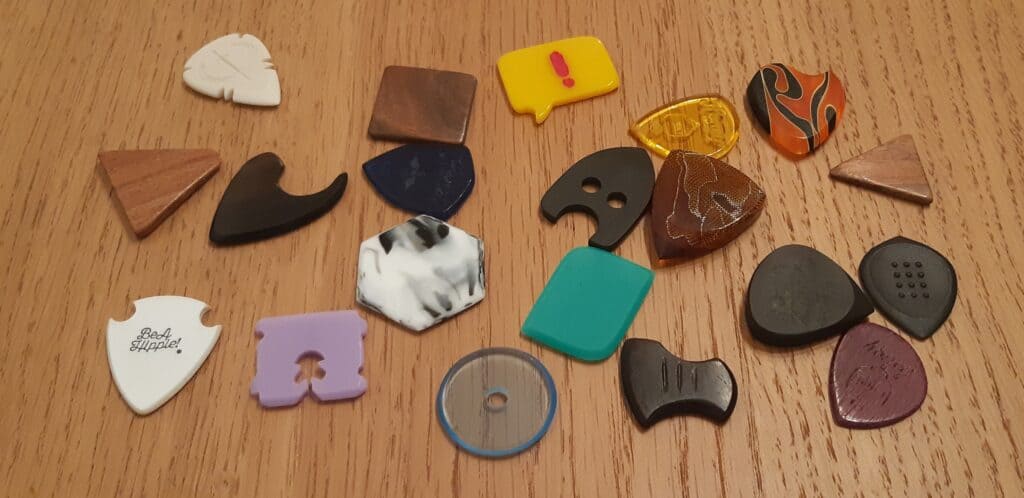
Guitar Picks Tip Shapes and Curves
This is a part of guitar picks that is often overlooked. It is divided into 2 sub-parts, as suggested by the headline: Tip shapes, and tip curves (or slopes).
Guitar Pick Tip Curve
A guitar pick’s tip curve is determined by the angle and shape of which it goes from the part you hold to the part of the pick that touches the strings. The tip curve is demonstrated very well in this image, which compares two different types of curves:

Guitar Pick Tip Shape (Normal or Speed Beveled)
The tip shape and bevel were originally modified by pick makers to improve playability. That being said, the tip bevel has a huge impact on the sound of a guitar pick, too. A good example of that is how Jazz III sounds different than Rock III (which is its speed beveled version).
Speed beveled picks sound more consistent, making upstrokes and downstrokes (as well as picking from above or below the string) sound almost the same, especially for players that tend to angle their pick when playing.

Guitar Picks Thickness (Gauge)
The pick’s gauge affects the playability and tone just as much as the material and the shape of the pick. Thinner picks are considered better for strumming and rhythm, while thicker ones are usually used for lead. That’s because thicker guitar picks are easier to control.
The tone of thin guitar picks is usually brighter than thicker ones. Thin picks also have limited dynamic range compared to heavier picks because they are harder to control. These two factors make them ideal for strumming chords. Thick picks, on the other hand, are mellower and more precise.
A pick’s gauge doesn’t only control its playability and tone but also has a lot to do with the pick’s durability. The thicker it is, the longer it will last.

Guitar Pick Thickness Chart
Each manufacturer has its own “key” for guitar pick gauges, most of the time, it will be somewhere along these lines:
- Extra thin (up to 0.44mm)
- Thin (0.45mm to 0.69mm)
- Medium (0.7mm to 0.84mm)
- Heavy (0.85mm to 1.19mm)
- Extra Heavy (1.2mm to 1.49mm)
- Super Heavy (1.5mm and up)
The reason behind this division is not to spread the gauges evenly between the most common thickness levels, but to group gauges that behave somewhat similarly. That’s the reason that the thinner the picks are, the smaller the steps between gauges. The difference between a 0.4mm pick to a 0.5mm one is greater than the difference between a 1.5mm pick to a 3mm one.
Guitar Picks Grip
Over the years, guitar picks manufacturers made different attempts for solving the most common problem guitar players have with picks: slipping. These ideas include gripping surfaces, using grippy materials, changing the pick shape, and even coming up with new materials that have a better grip.
Grippy Guitar Pick Materials
One approach to having a better grip on a pick is to use a material that is naturally grippy. A good example of that is Tortex, which is Dunlop’s variation of Delrin, which was designed with that in mind.
Grip Surfaces
Having a grippy surface on top of a pick is a very effective way to ensure the pick is not falling or moving. This concept can work in three different ways: Have the pick itself come with a raised/lowered grip, create a grippy accessory that can be attached to any pick, or completely redesign the pick so it’s less likely for it to fall or rotate. Examples
Guitar Pick Grips
The oldest and simplest solution to guitar picks slipping was to glue sandpaper to the picks. A lot of guitar players used to do that, including John Lennon, Les Paul, and more.
Today, there are many grips, made from different materials and in different designs you can try to find what works for you. These materials include Silicone, Cork, and different types of rubber, and the designs vary from simple stickers to a unit that is attached to the back side of the pick.
Examples of guitar pick grips include Monster Grips, Epic Accessories’ Grips, Livinwell’s Pick Grips, Fender’s Mojo Grip, Player’s Grip, Mr. Power’s Cork Grip, and Inkfonts’ Grips
Grip Surface on Guitar Picks
Here, too, there are different ways guitar pick makers tackled the grip problem. Some makers create a gripping surface from the same material as the pick, such as Dunlop’s Jazz III Max Grip and PrimeTone, D’Addario’s DuraGrip and NyPro, Swiss Picks, and most of Bog Street’s collection. Other makers are combining a few different materials, such as Honey Picks‘ Carpenter Bee and Dava Picks’ Power Grip.

Unique Pick Design That Prevents The Pick From Moving
This group includes picks designed in many creative ways to prevent the pick from moving while playing. It includes Snakepick, Pykmax UPP


Ergonomics
Playing guitar for a few hours per day can cause a lot of problems, including arthritis and carpal tunnel. Many of these issues are caused by holding the pick too tight and applying a lot of constant pressure on the palm and wrist. It’s true that you can release a lot of the pressure from your wrist by using a thicker pick, but some pick makers are addressing it with ergonomic pick designs.
The first ergonomic guitar pick was made by Jean-Charles Dugain of Dugain Picks in 1982, featuring thumb and index finger recesses. To this day, this is the most common ergonomic pick design. Companies such as Bog Street are taking the ergonomic design from a different direction by shaping the picks to “force” an effortless and healthier hand posture.

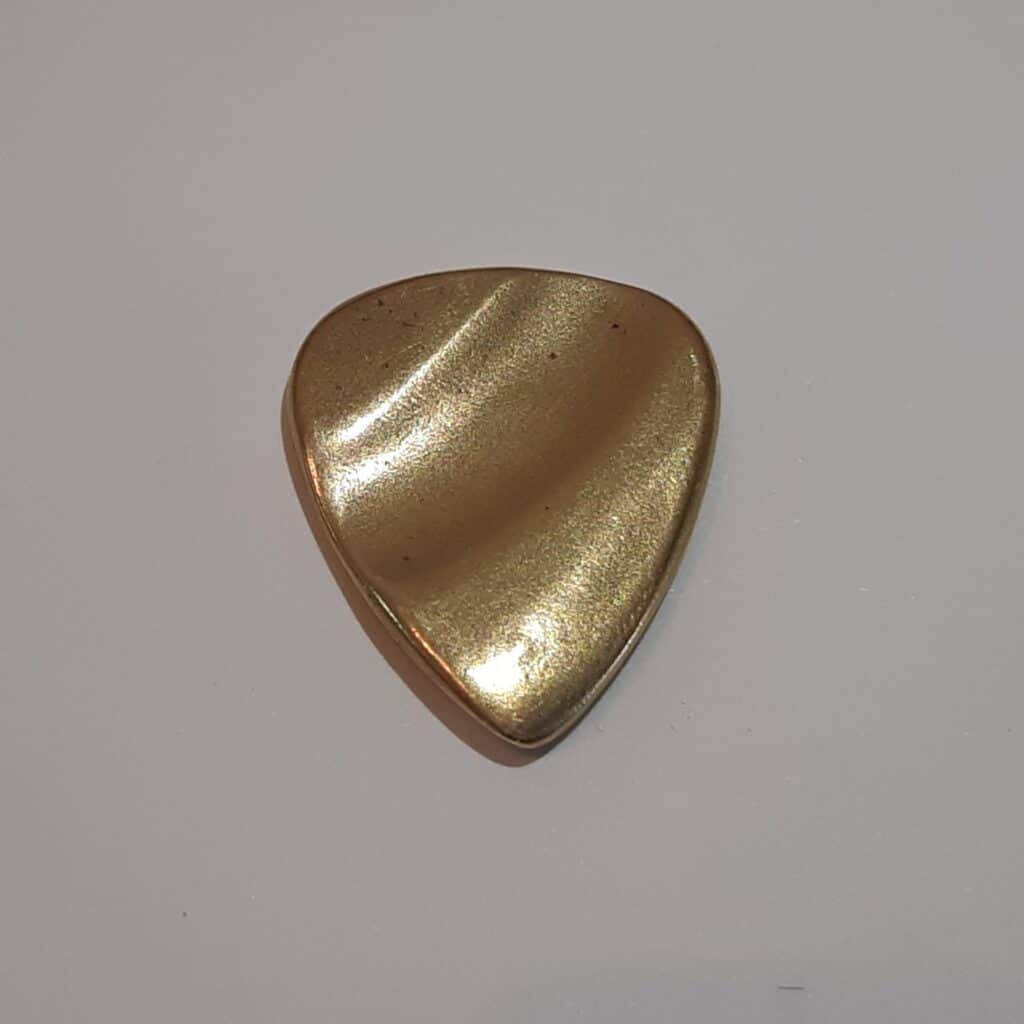
Finishing Thoughts
Guitar picks are an overlooked aspect of playing guitar, and I hope that I was able to do it some justice by showcasing all the differences between materials, shapes, and gauges.
I hope you enjoyed reading this article, and that you learn something new about guitar picks. If you have other things you want to add, a question to ask, or anything else – post them in the comments.
Wow! I didn’t know there are so many options for guitar picks
And there are many more 🙂
This was a great article. Thank you.
As a long time guitar player who is interested in trying out thicker picks is there something in particular (style, brand) you would recommend? I’ve always played with pretty thin picks or fingers.
I think that the most common material out of Tortex, Celluloid, Delrin, and Nylon is Acrylic. Go for a shape you are used to at around 3mm thick and see if you like it. There are great options made of Acrylic such as Honey Picks, Gravity Picks, and V-Picks. I recommended these because each of them has a big variety of traditionally shaped picks. If you want something a bit out of the box in terms of materials, there’s Chicken Picks, which uses some type of Thermosetting plastic that can last for years. Go over a few of the reviews I made, or browse the Heavy Repping shop, which is a store exclusively for boutique picks. Hope it helps.
Do people really play with such thick picks? I can’t imagine myself playing anything thicker than a jazz3
Yes! There are great reasons to play with thicker picks. Give this a read and see if it clears some doubts.
I really appreciate this post, I learned a lot. Thank you!
What about sizes? I want a thumb pick to fit my thumb which is 3″ circumference or 1″ diameter. I can get metal ones to fit but not anything plastic or plastic-like, i.e. tortex.
There’s a bit of a problem with thumb pick sizes because every maker makes their own sizing and it never fits perfectly. You can always try to heat it in hot water and shape it to fit, but there’s Black Mountain thumb picks that might work great for you
This is a great article on flat picks but really overlooks the wide variety of thumb picks. I recently discovered Black Mountain thumb picks and they are outstanding! They resolve the issue of fit since there is a spring that squeezes the pick on to your thumb. Other thumb picks tend to stretch over time but this spring really holds up. I find that it also works better as a flat pick when compared to other thumb picks.
I’m working on expanding this article to thumb picks, but it got to a length the demands being its own post. Not really sure How I’m going to do it, yet.
About Black Mountain, I totally agree, they are my favorites, too.
I never heared about most of these materials before, let alone knowing they are used to make guitar picks
This is the most comprehensive article on guitar picks that I’ve ever seen. I’ve been using Tortex shark fins 0.6mm for many years. After reading this article, I really want to experiment with other types, textures and thicknesses. It may inspire me to write some new material. Thanks for the information and inspiration.
Thanks for your kind words. It means a lot.